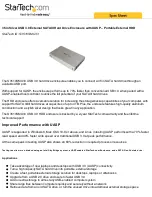
Appendix A – DGX Configuration Software
181
Instruction Manual – Enova DGX 8/16/32/64 Digital Media Switchers
EDID Programmer View
From the EDID Programmer view, EDID EEPROM chips on each of the DGX HDMI and DGX DVI Input Board
connectors can be re-programmed independently if necessary.
EDID Overview
EDID (Extended Display Identification Data) is a data structure established by the Video Electronics Standards
Association (VESA) to enable plug-and-play support by enabling easy configuration of a computer’s graphics subsystem
based on the capabilities of the attached display device.
EDID information includes items such as the following:
Manufacturer’s name
Product type
Supported video resolutions and refresh rates
Color space and filter chromaticity
Detailed timings
When a computer is directly connected to a display device, it can use the display device’s EDID information to
determine an initial compatible video signal to send. With the computer’s display controls, the user can modify this
selection to another compatible signal based on the provided EDID information.
With DVI and HDMI signals (both require EDID on the display devices), using EDID information has extended beyond
computers to other source devices, such as DVD players. As long as the source device sends a compatible signal, the
plug-and-play feature will work.
Digital Media Switchers and EDID
Digital Media Switchers, such as the Enova DGX, provide the ability to route one source signal to many potentially
different types of display devices. In almost all cases through the use of compatible DXLink Receivers or DGX SC Fiber
Receivers (both featuring SmartScale Technology), incompatibilities between source device resolutions and displays are
automatically resolved as each receiver independently scales each source device’s video to the display’s native
resolution.
In cases where local DVI or HDMI outputs are used and a resolution incompatibility exists (or if a source device needs a
specific resolution), the DGX DVI and DGX HDMI Input Boards have the ability to update the EDID emulation file
(by updating each input’s EEPROM chip) which comes pre-loaded with an AMX AutoPatch EDID set.
This EDID set consists of some of the most common EDID settings in use today, including VESA and HDTV settings
encompassing resolutions for Standard Timings and resolutions for Established Timings (for HDMI timing details,
see page 73; for DVI, see page 82). In many cases, the switcher can be used straight out of the box with no adjustments
(see “Determining the Need for EDID Re-programming” on page 182).
The DGX Configuration Software with EDID programming functionality has been provided for cases where additional
in-field programming of a board’s input connectors EDID chips is needed. The EDID Programmer view can be used for
the following:
Reading and saving EDID data in hexadecimal from an output receiving the information from its attached
destination device
Writing EDID data to the Enova DGX input connector’s associated EDID EEPROM
Important:
Any analysis or editing of the EDID data necessary to support the equipment specific to the
installation will need to be done separately prior to using the EDID Programmer view. A variety of freeware
tools can be found on the Internet to help with these tasks.
Keep in mind that the EDID information for some equipment may not be compatible with the remaining equipment even
with re-programming. In those cases, the signals will have limited routing options.
Tip:
If the signal from some of the equipment can only be routed to part of the destinations due to
incompatible EDIDs, control can be simplified by creating a separate virtual matrix for the inputs and outputs
involved (see “Creating a New Virtual Matrix” in the XNConnect Help file).
The remaining sections for the EDID Programmer view provide information on:
Determining the need for EDID re-programming
Reading and saving EDID data from an output, which received the information from its attached destination
device
Writing data to an Enova DGX input connector
Additional HDMI EDID files for handling audio concerns
















































